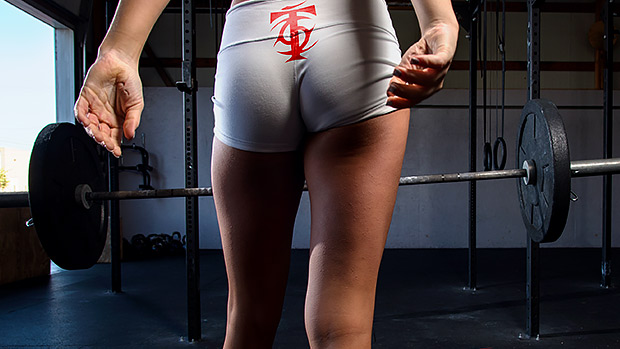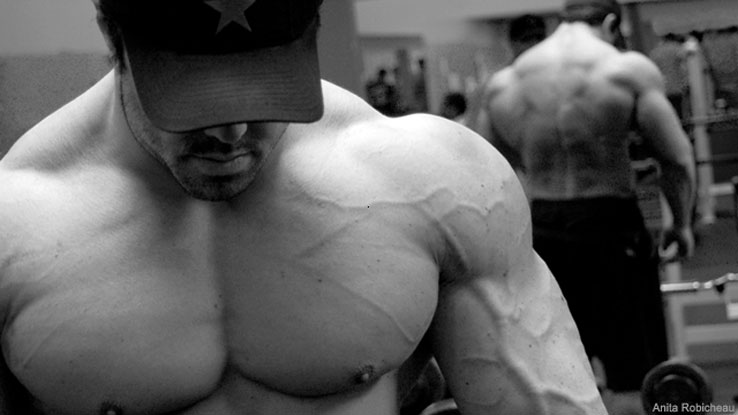Traditional lifting exercises have a concentric and an eccentric phase. The concentric phase is where muscle contractions overcome the resistance load. It usually occurs when the load is lifted "up." Think of the first half of a deadlift: you lift the weight up.
The eccentric phase is where resistance overcomes the opposing muscles, which are actively contracting to decelerate or control the load. Practically speaking, the eccentric is the lowering phase – the negative.
Advanced training techniques that emphasize the eccentric phase of a lift have received well-deserved attention for their ability to promote strength, power, and hypertrophy (1).
However, we must not overlook the concentric contraction. In fact, this article is all about concentric-only sets, which cut out the eccentric/negative phase entirely. Use concentric-only sets to increase volume, train at high frequency, promote neural adaptation, and possibly even bias certain regions of the muscle belly. We'll get back to the science (and application) of concentric-only training in a bit.
Most gyms have bumper plates and platforms these days, making it okay to drop the weights (within reason, Planet Fitness excluded). This makes concentric-only training more do-able for regular people who don't train in a university's athletic complex.
Yes, I said, "drop the weights." To eliminate the eccentric phase, you simply drop the weights at the top of a traditional lift.
Granted, some exercises are more feasible than others for concentric-only sets, but here are four you can do with a barbell and droppable plates.
Weightlifting coach Glenn Pendlay popularized this row. The major distinctions between this row and the strict bent-over barbell version are the grip width and the bar path.
For the Pendlay row, hinge forward at the hips to get your torso as close to parallel to the floor as possible. Use a wide overhand grip (close to a snatch grip), which promotes a bar path that leads toward the sternum, as opposed to the stomach.
The higher bar path changes the primary movement pattern of the shoulder complex. With the Pendlay row, you downplay the latissimus dorsi in favor of the upper back, namely, the posterior delts, mid traps, and rhomboids.
This variation will get you a pump without the fatiguing after-effects that might interfere with your next upper-body pulling or arm session.
Place a folded towel or foam mat under your knees for comfort. The tall kneeling position is practical for this lift because you don't have to bend down to retrieve the barbell. It's also much more difficult to "cheat" your curls in this position.
Heavy traditional deadlifts can leave you feeling flat for several days. Try this variation to minimize recovery time by eliminating the eccentric. Simply release the bar at the top of your conventional or sumo deadlift.
Although this is an Olympic lifting derivative or progression, you don't need to practice the Olympic lifts to benefit from it. It'll build the delts, upper traps, and re-enforce force transmission through the kinetic chain.
Grasp the bar slightly wider than shoulder-width using an overhand grip. The lift starts with the bar just above the kneecaps with your weight primarily on the front of your feet and your hips slightly flexed for the "hang" position.
Extend your hips to get the bar moving vertically. Your heels will likely float off the ground when you perform your hip drive, but don't force a jump. Do a few traditional hang high pulls first to be sure your bar path is vertical – not toward your face – before releasing the bar at the top of the movement.
Okay, here's the science. There's evidence indicating that concentric and eccentric contractions cause regional differences in growth within the muscle belly. You've probably heard of the "biceps peak" and "inner pecs."
Although I hate these terms, they refer to the prominence of certain regions of the muscle belly. One study indicates that concentric-only training causes preferential hypertrophy of the middle region of the vastus lateralis, which is the outer sweep of the quadriceps (2).
Granted, another study on concentric-only versus eccentric-only training appears to refute that (3). But the training program used by the concentric-only group in this study failed to deliver any notable growth, which indicates programming may have been sub-optimal.
So it's not known whether we can sculpt parts of muscle bellies in various areas of the body with different contraction types. However, there's a strong positive relationship between volume and hypertrophy within a recoverable range. If you can add a bit more volume using concentric-only work without harming recovery, it could help you tack on more mass.
Strength coaches have long programmed primarily concentric lifts – power cleans and snatches – to produce a potent training effect without significant compromise to athlete preparedness for upcoming events. This practice can be easily understood with a light dose of muscle contraction physiology. At the same load, the concentric portion of a lift causes greater muscle fiber recruitment than the eccentric portion (4).
This phenomenon may be explained by the role of a protein called titin (5). Its chemical name is so long it takes three hours to say.
Titin contributes significantly to total muscle force during the eccentric phase. Heavy eccentric exercise results in damage to the muscle's titin machinery, which peak several days after exercise (6). This finding corresponds to muscle soreness and the decreased strength and performance we often experience after emphasizing the eccentric phase.
Concentric-only training avoids the damage to titin by eliminating the eccentric phase (6). During concentric contractions, the absence of the "boost" from titin means that active recruitment of more muscle is necessary to accomplish the lift. Therefore, concentric-only training ensures that the neuromuscular system is adequately stimulated by high levels of muscle recruitment with little to no decrease in strength in the following days (7).
Finally, because concentric-only lifts begin from a dead-stop, you can't bounce out of the bottom into the next rep. This means you can't really use the stretch-shortening cycle with concentric-only training, which enhances the efficiency of the lift via reflex activity and elastic energy.
This changes the force and power profile of the lift (8), demands greater neuromuscular activity earlier in the lift (4), and ultimately makes a set of concentric-only lifts feel like a string of heavy singles.

Although we can build muscle and strength with concentric-only training, I'm not suggesting we abandon traditional concentric-eccentric exercise. Traditional resistance training will always be the bread and butter of every good strength program.
I'm also not suggesting we avoid emphasized eccentric exercise. Regular performance of eccentric exercise provides protection against the muscle damage discussed above via the "repeated bout effect" (9). However, there are times when it's appropriate to strategically slip sets of concentric-only training into your program.
Here are two opportunities:
1. Extra Volume
You can add "bonus" volume for a lagging body part without fear of harming recovery or performance in the subsequent workout.
For example, if you normally do 6 traditional sets of rows on back day, add 2-3 sets of concentric-only Pendlay rows. For a vertical pull, set a box or stack of those bumper plates under the pull-up bar to step onto after the "up" phase.
Because concentric-only sets represent the most challenging and energetically-demanding half of the lift, place them before your traditional sets. Bonus: Dropping weights will get you fired up for your traditional sets.
2. Extra Frequency
Hit the same muscles and movements more often throughout your training week by adding concentric-only sets.
If you use a split routine, adding 2-3 sets of any of these concentric-only exercises to a session with a different muscle group or movement focus is unlikely to harm your recovery. For example, add the concentric-only biceps curl on a lower-body push day, or hit some concentric-only hang high pulls on chest day.
Substitution
Alternatively, when you're feeling banged up from accumulated delayed onset muscle soreness, simply exchange sets of traditional resistance training with concentric-only sets.
You'll get the work in, make some noise, and leave feeling better than you did when you arrived. And ultimately, isn't that what you all want from your workout anyway?
- Suchomel TJ et al. Implementing eccentric resistance training—Part 1: A brief review of existing methods. J Funct Morphol. 2019;4(2):38.
- Franchi MV et al. Architectural, functional, and molecular responses to concentric and eccentric loading in human skeletal muscle. Acta Physiol. 2014;210:642–654.
- Vikne H et al. Muscular Performance after concentric and eccentric exercise in trained men. Med Sci Sport Exer. 2006;38(10):1770-1781.
- Pasquet B et al. Specific modulation of motor unit discharge for a similar change in fascicle length during shortening and lengthening contractions in humans. J Physiol. 2006;577(2):753-65.
- Hessel AL et al. Physiological mechanisms of eccentric contraction and its applications: A role for the giant titin protein. Front Physiol. 2017;8:70.
- Yamaguchi S et al. Changes in urinary titin N-terminal fragment concentration after concentric and eccentric exercise. J Sports Sci Med. 2020 Feb 24;19(1):121-129. PMID: 32132835; PMCID: PMC7039023.
- Bottas R et al. Repeated maximal eccentric actions causes long-lasting disturbances in movement control. Eur J Appl Physiol. 2005;94:62-69.
- Zemková E et al. Enhancement of peak and mean power in concentric phase of resistance exercises. J Strength Cond Res. 2014;28(10):2919-2926.
- Hyldahl RD et al. Mechanisms and mediators of the skeletal muscle repeated bout effect. Exerc Sport Sci Rev. 2017;45(1):24-33.





